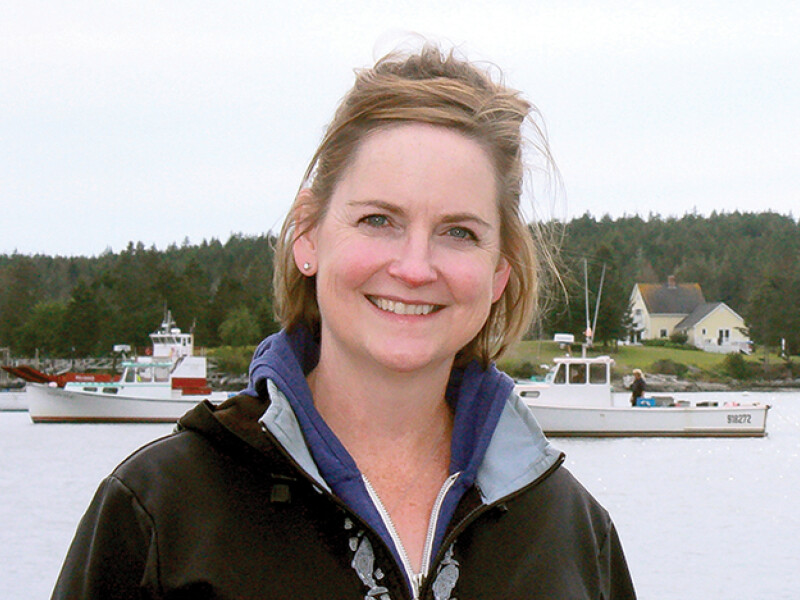She never saw the ocean until she was 18 years old, but Jennifer Lincoln has established a strong bond with the sea and the commercial fishing industry.
“When I was in college, I went to Alaska for a summer internship,” says Lincoln. “It was only supposed to be that summer, but I met my husband. He was stationed there in the Air Force. We met in 1990 and got married in ’91.”
In 1992, the National Institute for Occupational Safety and Health opened a field office in Alaska, and Lincoln began her career safeguarding the lives and health of fishermen.
“Part of my job was to read the newspapers and keep track of all work-related deaths in Alaska,” says Lincoln. “I knew that fishing had the most deaths. And as an epidemiologist, I was looking for patterns related to those injuries. I come from a small town, and a lot of those values translate to the fishing industry. I understand that the desire to do this work, fishing, is generational, much like farming, and I wanted to look at this in ways that were relevant to fishermen.”
Lincoln looked at more than just numbers. She analyzed injuries and fatalities as they related to fisheries and vessel types, so that solutions could be tailored to the realities of how vessels and crew work.
“I don’t believe in one size fits all,” she says. “I didn’t know fishing, but I knew how to listen. It struck me when I went to a meeting of researchers and fishermen, and there were people there who wanted to focus on dermatitis and crab asthma. I said this is an industry where almost everyone knows someone who has died in the last three years. We have to talk about what matters. If you’re talking to crabbers, you talk stability. If you’re talking to Bristol Bay gillnetters, you talk about man-overboard and how not to get tangled up in the gear.”
Lincoln notes that while everyone hears about the major sinkings like the Destination or the Scandies Rose, crew members who fall overboard or suffer career-ending injuries don’t always make the news.
“We need to move down the scale of severity and talk about the important things at the right time,” says Lincoln. “For example, I went to a meeting of the Fishing Vessel Advisory Committee, which advises the Coast Guard on safety regulations, and there was a guy there, Jimmy Ruhle, from North Carolina, and he was really mad. We were talking about PFD research and he said, ‘Why don’t you give these life jackets to us, and let us tell you what we think?’”
Lincoln listened to Ruhle (also an NF Highliner), and combined her statistical research with what fishermen tell researchers about what will work for a crewman on deck. In addition to Alaska, Lincoln now works nationally, and her work inspired another pilot project to prevent man-overboard incidents in the Northeast lobster fishery, called Lifejackets for Lobstermen.
“One of the great things that came out of that PFD research was that a company called Kent Safety Products came up with a vest, called the Rogue Vest, based on the information NIOSH collected from fishermen,” she says, adding that she would rather see vessel owners require life vests that work for their vessels and fisheries than see a life jacket mandate at the federal level.
She has also voiced concerned with how regulations can contribute to vessel loss, noting that some boats may take excessive risks to establish catch history prior to a fishery being rationalized, or managed through individual fishing quotas.
“It might be useful to have someone knowledgeable at the table when regulators are making the rules,” she says.
In addition to her work in Alaska and in other parts of the country, Lincoln is also recognized internationally. She has served on an Expert Consultation to the FAO on how fisheries management affects safety. She is also leads the organization of the International Fishing Industry Safety and Health Conference (IFISH).
While many fishermen appreciate Lincoln’s work, she’s no stranger to industry pushback.
“I was at a trade show and a fisherman got mad at me because I suggested requiring safety training,” she recalls. “I can statistically demonstrate a decline in injuries from safety training. So he and I talked, and in the end he agreed that a free, eight-hour safety training course was something he wanted.”
She notes that safety training should also be refreshed.
“If you took a course in the 1990s, you should update that, because technology and methods change.”
While fishing remains a dangerous occupation, NIOSH statistics show a general decline in fatalities and injuries. Lincoln has earned her recognition by being part of that positive change, and she is quick to point out that one of the key factors is that fishermen’s attitudes toward safety are changing.
“I was talking to an older fisherman in Alaska,” says Lincoln. “And he thought it was because his generation of fishermen got older, they started families and they became more concerned with safety.”
However we came to be here in the midst of changing attitudes about safety, we’re lucky to have leaders like Lincoln who support the industry with compassion for the people who are out there on the boats in all kinds of weather.







